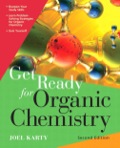
Concept explainers
(a)
Interpretation:
For the given reaction, the major product is to be determined. The complete, detailed mechanism is to be drawn.
Concept introduction:
When the attacking species is an alcohol which is a weak base and weak nucleophile, it favors
Answer to Problem 9.81P
The complete, detailed mechanism and the major product for the given reaction is shown below:

Explanation of Solution
The given reacting species are shown below:

In the given reaction, attacking species is an alcohol which is a weak nucleophile. Also, the leaving group can be water under acidic conditions which is an excellent leaving group. Also, the solvent is an alcohol. Therefore, the given reaction favors

The complete, detailed mechanism and the major product for the given reaction is drawn on the basis of reacting species.
(b)
Interpretation:
For the given reaction, the major product is to be determined. The complete, detailed mechanism is to be drawn.
Concept introduction:
When attacking species is an alcohol which is a weak base and weak nucleophile, it favors
Answer to Problem 9.81P
The complete, detailed mechanism and the major product for the given reaction is shown below:
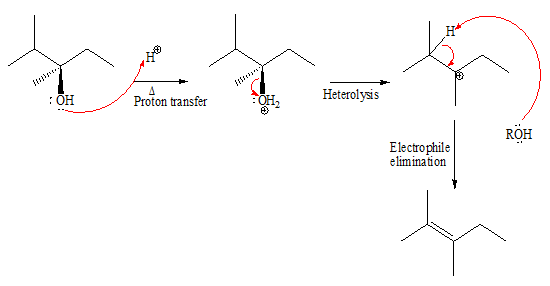
Explanation of Solution
The given reacting species are shown below,

In the given reaction, attacking species is an alcohol which is a weak nucleophile. Also, the leaving group can be water under acidic conditions which is an excellent leaving group. Also, the solvent is an alcohol. Therefore, the given reaction favors

The complete, detailed mechanism and the major product for the given reaction are drawn on the basis of reacting species.
(c)
Interpretation:
For the given reaction, the major product is to be determined. The complete, detailed mechanism is to be drawn.
Concept introduction:
When attacking species is an alcohol which is a weak base and weak nucleophile, it favors
Answer to Problem 9.81P
The complete, detailed mechanism and the major product for the given reaction is shown below:

Explanation of Solution
The given reacting species are shown below,

In the given reaction, attacking species is an alcohol which is a weak nucleophile. Also, the leaving group can be water under acidic conditions which is an excellent leaving group. Also, the solvent is an alcohol. Therefore, the given reaction favors 
The complete, detailed mechanism and the major product for the given reaction are drawn on the basis of reacting species.
(d)
Interpretation:
The major product of the given reaction is to be determined. The complete, detailed mechanism is to be drawn.
Concept introduction:
When attacking species is an alcohol which is a weak base and weak nucleophile, it favors
Answer to Problem 9.81P
The complete, detailed mechanism and the major product for the given reaction is shown below,
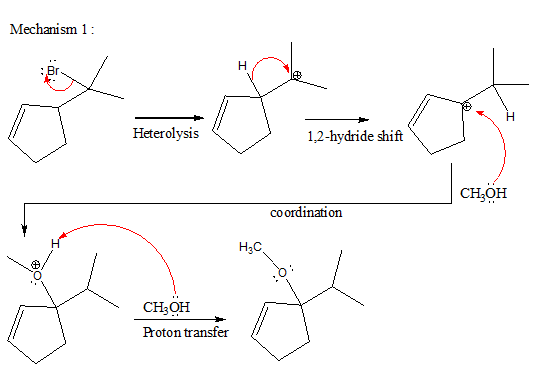

Explanation of Solution
The given reacting species are shown below,

In the given reaction, attacking species is an alcohol which is a weak nucleophile. Also, the leaving group can be water under acidic conditions which is an excellent leaving group. Also, the solvent is an alcohol. Therefore, the given reaction favors


The complete, detailed mechanism and the major product for given reaction are drawn on the basis of reacting species.
(e)
Interpretation:
For the given reaction, the major product is to be determined. The complete, detailed mechanism is to be drawn.
Concept introduction:
The strong nucleophile and weak base favors
Answer to Problem 9.81P
The complete, detailed mechanism and product of the given reaction is as shown below:

Explanation of Solution
The given reacting species are shown below,

The Br- is a strong nucleophile but a weak base that favors
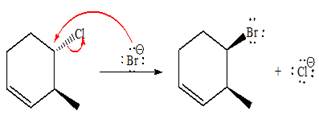
The complete, detailed mechanism and the major product for the given reaction are drawn on the basis of reacting species.
(f)
Interpretation:
For the given reaction, the major product is to be determined. The complete, detailed mechanism is to be drawn.
Concept introduction:
If the attacking species is a strong bulky base but has low concentration it favors
Answer to Problem 9.81P
The complete, detailed mechanism and the products of the given reaction are shown below,
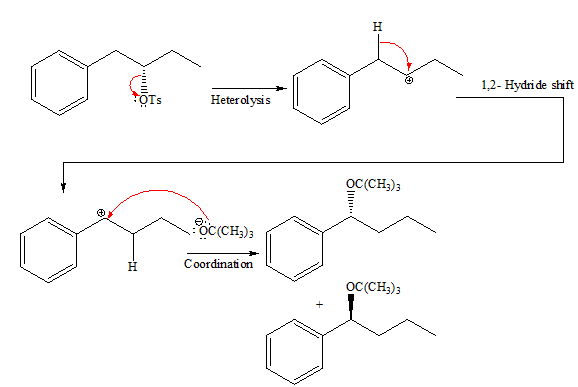
Explanation of Solution
The given reacting species are shown below,

In the given reaction, the attacking species is a strong bulky base so it favors

The complete, detailed mechanism and the major product for the given reaction is drawn on the basis of reacting species.
(g)
Interpretation:
For the given reaction, the major product is to be determined. The complete, detailed mechanism is to be drawn.
Concept introduction:
When attacking species is an alcohol which is a weak base and weak nucleophile, it favors
Answer to Problem 9.81P
The complete, detailed mechanism and the major product for the given reaction is shown below,
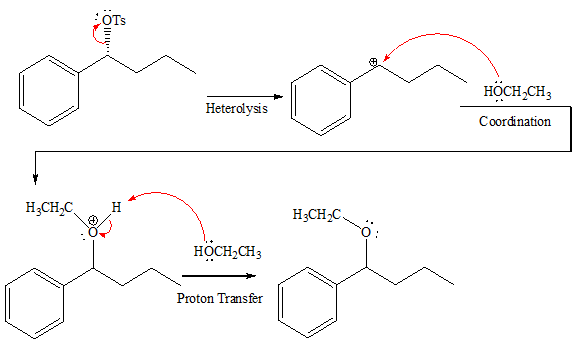
Explanation of Solution
The given reacting species are shown below:

In the given reaction, attacking species is a weak nucleophile and weak base. Also, the leaving group

The complete, detailed mechanism and the major product for the given reaction are drawn on the basis of reacting species.
Want to see more full solutions like this?
Chapter 9 Solutions
EBK GET READY FOR ORGANIC CHEMISTRY
- For the reaction A (g) → 3 B (g), Kp = 0.379 at 298 K. What is the value of ∆G for this reaction at 298 K when the partial pressures of A and B are 5.70 atm and 0.250 atm?arrow_forward14. Calculate the concentrations of Ag+, Ag(S2O3), and Ag(S2O3)23- in a solution prepared by mixing 150.0 mL of 1.00×10-3 M AgNO3 with 200.0 mL of 5.00 M Na2S2O3 Ag+ + S20 Ag(S203)¯ K₁ = 7.4 × 108 Ag(S203)¯ + S20¯ = Ag(S203) K₂ = 3.9 x 104arrow_forwardΗΝ, cyclohexanone pH 4-5 Draw Enamine I I CH3CH2Br THF, reflux H3O+ I Drawing Draw Iminium Ionarrow_forward
- :0: :0: Select to Add Arrows :0: (CH3)2NH :0: ■ Select to Add Arrows :0: :0: (CH3)2NH ■ Select to Add Arrowsarrow_forwardDraw the product of the following H action sequence. Ignore any inorganic byproducts formed. 1. (CH3CH2)2CuLi, THF 2. CH3Br Q Atoms, Bonds and Rings H Charges ㅁarrow_forwardPlease help me with this the problem is so confusingarrow_forward
- 14 Question (1 point) Disiamylborane adds to a triple bond to give an alkenylborane. Upon oxidation with OH, H2O2, the alkenylborane will form an enol that tautomerizes to an aldehyde. In the first box below, draw the mechanism arrows for the reaction of disiamylborane with the alkyne, and in the last box draw the structure of the aldehyde. 4th attempt Feedback i > 3rd attempt OH, H2O2 i See Periodic Table See Hintarrow_forwardanswer with mechanisms and steps. handwritten please!arrow_forwardHello I need some help with Smartwork. For drawing structure B, I know the correct answer is CH₃B₂, but when I try to type it in, it keeps giving me CH₄BH₃ instead. Do you know how I should write it properly? Should I use a bond or something else?arrow_forward
 Organic Chemistry: A Guided InquiryChemistryISBN:9780618974122Author:Andrei StraumanisPublisher:Cengage Learning
Organic Chemistry: A Guided InquiryChemistryISBN:9780618974122Author:Andrei StraumanisPublisher:Cengage Learning
